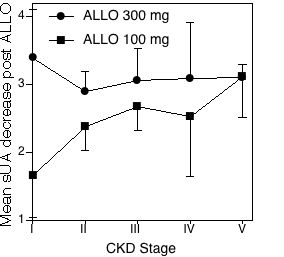Session Information
Session Type: Abstract Submissions (ACR)
Background/Purpose: Patients with chronic kidney disease (CKD) may be at increased risk for allopurinol (ALLO) hypersensitivity, possibly because impaired renal excretion causes accumulation of the active ALLO metabolite oxypurinol (OXY). For this reason, lower doses of ALLO are recommended when initiating urate lowering in CKD patients. OXY accumulation suggests that ALLO should also be more efficacious in CKD patients, a hypothesis not previously tested. We therefore assessed whether ALLO is more effective at lowering serum urate (sUA) in patients with CKD vs those with normal renal function.
Methods: Using the electronic medical record of the NY Harbor VA Health Care System, we identified all gout patients taking 100 mg or 300 mg of ALLO daily between August 2007 and August 2008 for whom both pre- and post-treatment sUAs were available. ALLO use was identified using pharmacy records and confirmed by individual chart review. Baseline characteristics were obtained. Patients in each ALLO dose group were categorized by National Kidney Foundation stages, and mean change in sUA for each ALLO dose according to CKD stage was determined.
 Results: Among 1288 charts reviewed, 199 patients met entry criteria and had sufficient data to permit evaluation. 95 patients were taking 100 mg and 104 were taking 300 mg ALLO daily. 100 mg vs 300 mg groups were similar in age (71.4±1.2 vs 68.7±1.1 years) and BMI (29.1±0.6 vs 30.9±0.6). Overall, patients taking 300 mg experienced a trend toward greater sUA decrease vs those taking 100 mg (2.9±0.2 vs 2.5±0.2 mg/dL, p=0.13), resulting in a lower post-treatment mean sUA in the 300 mg group (7.0±0.2 mg/dL for 100 mg dose, 6.1±0.2 mg/dL for 300 mg dose, p=0.001). Across increasing degrees of renal insufficiency, mean decreases of sUA in patients taking 300 mg did not change significantly. In contrast, in patients taking 100 mg, decreases in sUA (in mg/dL) increased progressively from stage I to V CKD: stage I (n=10) sUA decrease = 1.7±0.6, stage II (n=25) = 2.4±0.4, stage III (n=46) = 2.7±0.4, stage IV (n=8) = 2.5±0.9, stage V (n=6) = 3.1±0.6. Whereas patients with normal renal function (stage I) experienced greater sUA lowering with 300 mg vs 100 mg (3.4±0.7 vs 1.7±0.6 mg/dL, p=0.04), 100 mg ALLO was as efficacious as the 300 mg dose in patients with stage V CKD (sUA decrease 3.1±0.6 vs 3.1±0.2 mg/dL, p=0.5).
Results: Among 1288 charts reviewed, 199 patients met entry criteria and had sufficient data to permit evaluation. 95 patients were taking 100 mg and 104 were taking 300 mg ALLO daily. 100 mg vs 300 mg groups were similar in age (71.4±1.2 vs 68.7±1.1 years) and BMI (29.1±0.6 vs 30.9±0.6). Overall, patients taking 300 mg experienced a trend toward greater sUA decrease vs those taking 100 mg (2.9±0.2 vs 2.5±0.2 mg/dL, p=0.13), resulting in a lower post-treatment mean sUA in the 300 mg group (7.0±0.2 mg/dL for 100 mg dose, 6.1±0.2 mg/dL for 300 mg dose, p=0.001). Across increasing degrees of renal insufficiency, mean decreases of sUA in patients taking 300 mg did not change significantly. In contrast, in patients taking 100 mg, decreases in sUA (in mg/dL) increased progressively from stage I to V CKD: stage I (n=10) sUA decrease = 1.7±0.6, stage II (n=25) = 2.4±0.4, stage III (n=46) = 2.7±0.4, stage IV (n=8) = 2.5±0.9, stage V (n=6) = 3.1±0.6. Whereas patients with normal renal function (stage I) experienced greater sUA lowering with 300 mg vs 100 mg (3.4±0.7 vs 1.7±0.6 mg/dL, p=0.04), 100 mg ALLO was as efficacious as the 300 mg dose in patients with stage V CKD (sUA decrease 3.1±0.6 vs 3.1±0.2 mg/dL, p=0.5).
Conclusion: In patients with gout, low-dose ALLO is progressively more effective for sUA lowering in proportion to increasing degrees of renal insufficiency, presumably owing to OXY accumulation. No such effect was seen at the 300 mg dose, suggesting that sUA-lowering effects may reach a ceiling in CKD patients. These data support the strategy of starting gout patients with CKD on low-dose ALLO and titrating upwards only as needed, not only to minimize toxicity, but also because lower doses may be more effective in CKD patients, and higher doses may confer little or no additional benefit.
Disclosure:
M. DeBerardine,
None;
M. C. Fisher,
None;
R. T. Keenan,
None;
M. H. Pillinger,
None;
D. B. Crittenden,
None.
« Back to 2012 ACR/ARHP Annual Meeting
ACR Meeting Abstracts - https://acrabstracts.org/abstract/low-dose-allopurinol-promotes-greater-serum-urate-lowering-in-gout-patients-with-chronic-kidney-disease-vs-normal-renal-function/
